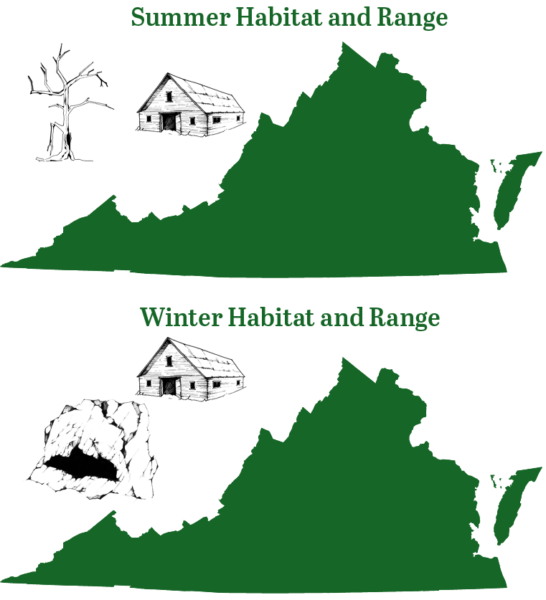Fact File
Scientific Name: Eptesicus fuscus
Classification: Mammal, Order Chiroptera
Conservation Status:
- Appears to be secure in Virginia. Inhabits a wide variety of habitats and is locally abundant.
Identifying Characteristics
The big brown bat is one of the largest bats in the state, measuring 4.0–5.1 inches in length and weighing between 0.5–0.75 ounces. Their large size and uniformly brown fur color make them one of Virginia’s easiest bats to identify. The big brown bat has a large head, short rounded ears, and a naked muzzle.
Habitat
The big brown bat is found across the entire state and is one of the most common bats in the United States. It often hibernates in manmade structures including old buildings and churches but will use caves and rock shelters. It is a solitary hibernator but can occasionally be found in small clusters. During the summer, this bat is often found in barns, sheds, and old buildings. Females form maternity colonies under loose bark or in manmade structures. Occasionally, males may roost near the females but they typically are solitary.
Diet
They often emerge before dusk to feed and most foraging occurs within 1.2 miles of the roost site. Big brown bats can eat up to ⅓ their body weight in insects every night, frequently feeding on agricultural pests.
Maternity
Maternity colonies are often found in old structures like church steeples, old houses, and barns and may consist of several hundred individuals including both males and females. The females will congregate in the higher, warmer areas while the males remain isolated individually in the lower regions of the structure.
Last updated: January 19, 2024
ShopDWR
Order your copy of A Guide to the Bats of Virginia, along with more gear, guides, and gifts!
Visit ShopDWRThe Virginia Department of Wildlife Resources Species Profile Database serves as a repository of information for Virginia’s fish and wildlife species. The database is managed and curated by the Wildlife Information and Environmental Services (WIES) program. Species profile data, distribution information, and photography is generated by the Virginia Department of Wildlife Resources, State and Federal agencies, Collection Permittees, and other trusted partners. This product is not suitable for legal, engineering, or surveying use. The Virginia Department of Wildlife Resources does not accept responsibility for any missing data, inaccuracies, or other errors which may exist. In accordance with the terms of service for this product, you agree to this disclaimer.


